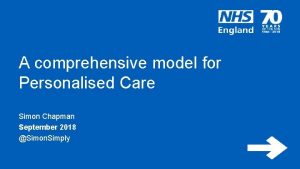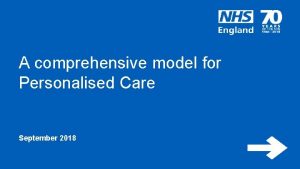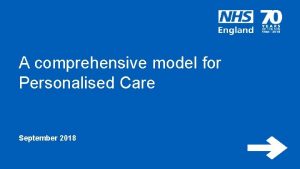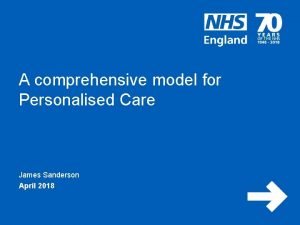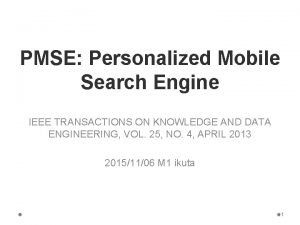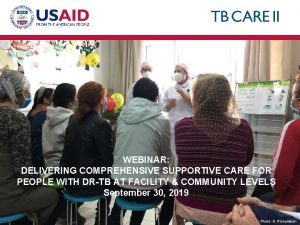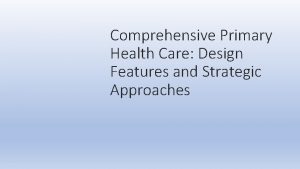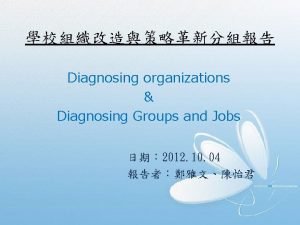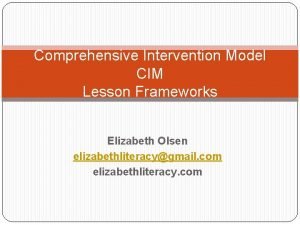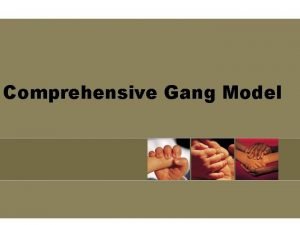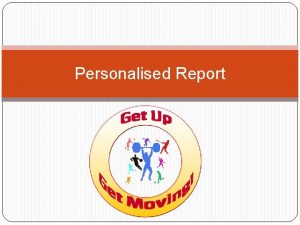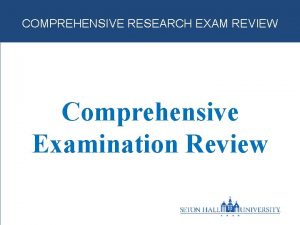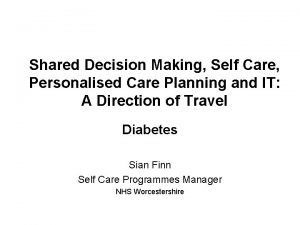A comprehensive model for Personalised Care Simon Chapman














- Slides: 14

A comprehensive model for Personalised Care Simon Chapman September 2018 @Simon. Simply www. england. nhs. uk

Comprehensive Model for Personalised Care All age, whole population approach to Personalised Care TARGET POPULATIONS INTERVENTIONS OUTCOMES Specialist ING BE LL WE G AN CH People with long term physical and mental health conditions 30% D AN ITY OM PL EX GC SIN TH RE A Supporting people to build knowledge, skills and confidence and to live well with their health conditions. AL HE INC IR HE ES Universal Shared Decision Making. Enabling choice (e. g. in maternity, elective and end of life care). Social prescribing and link worker roles. Community-based support. ST EA Plus Universal interventions V MO Targeted People with complex needs 5% E PL Plus Universal and Targeted interventions Proactive case finding and personalised care and support planning through General Practice. Support to self manage by increasing patient activation through access to health coaching, peer support and self management education. Empowering people, integrating care and reducing unplanned service use. O PE Integrated Personal Commissioning, including proactive case finding, and personalised care and support planning through multidisciplinary teams, personal health budgets and integrated personal budgets. Whole population 100% Supporting people to stay well and building community resilience, enabling people to make informed decisions and choices when their health changes.

Personalised Care Operating Model WHOLE POPULATION 30% OF POPULATION when someone’s health status changes People with long term physical and mental health conditions Cohorts proactively identified on basis of local priorities and needs LEADERSHIP, COPRODUCTION AND CHANGE ENABLER Shared Decision Making Personalised Care and Support Planning People are supported to a) understand the care, treatment and support options available and the risks, benefits and consequences of those options, and b) make a decision about a preferred course of action, based on their personal preferences and, where relevant, utilising legal rights to choice (All tiers) People have a proactive, personalised conversation which focuses on what matters to them, delivered through a six-stage process and paying attention to their clinical needs as well as their wider health and wellbeing. Social Prescribing and Community-Based Support WORKFORCE ENABLER Optimal Medical Pathway Enables professionals to refer people to a ‘link worker’ to connect them into community-based support, building on what matters to the person and making the most of community and informal support (All tiers) Review FINANCE ENABLER A key aspect of the personalised care and support planning cycle. Check what is working and not working and adjust the plan (and budget where applicable) Supported Self Management Support people to develop the knowledge, skills and confidence (patient activation) to manage their health and wellbeing through interventions such as health coaching, peer support and self-management education (Targeted and Specialist) Personal Health Budgets and Integrated Personal Budgets An amount of money to support a person’s identified health and COMMISSIONINGA wellbeing needs, planned and ND PAYMENT agreed between them and their ENABLER local CCG. May lead to integrated personal budgets for those with both health and social care needs (Initially Specialist)

Personalised Care Group Programmes Legal Rights to Choice Patient Activation Measurement Social Prescribing and Community Based Interventions National Wheelchair Programme National End of Life Care Programme www. england. nhs. uk (Nine distinct programmes focussed on National Priorities e. g. Mental Health, LD, CHC) Maternity Pioneers Shared Lives Plus Shared Decision Making / Person Centred Care & Support Planning Self Care/Self Management Support 4

Significant delivery of Personalised Care Shared decision making In 2017/18 SDM was embedded into: • Musculoskeletal elective care pathways in 13 CCGs • Respiratory elective care pathways in 8 CCGs Social prescribing & community-based support • 68, 977 referrals in 2017/18 • 331 link workers employed in local areas Personalised care and support planning Enabling choice • 75, 914 people had a personalised care and support plan by March 2018 • Over 180, 000 people supported by integrated, personalised approaches • 83% of CCGs have now completed Choice Planning and Improvement self -assessment • Of these, 80% also now have a patient choice improvement plan Personal health budgets & integrated personal budgets Supported self management • Over 70, 000 patient activation assessments delivered in total • 8, 229 people attended group-based or peer support activities • 16, 000 people had self-management education or health coaching • • 28, 040 PHBs by March 2018 83% up year-on -year in 2018 -19 to date 15% jointly funded with social care 19, 241 Personal Maternity Care Budgets delivered by March 2018 across 36 CCGs

Emerging Evidence Across Continuing Health Care, direct savings of up to 17%; indirect savings of £ 4 k person WARRINGTON Personal health budgets in end of life care - 83% were able to die in a place of their choosing, against an average of 26% One week’s worth of traditional services funds six weeks of services commissioned through a personal health budget www. england. nhs. uk FYLDE COAST 85% improved or maintained level of patient activation (average shift of 9. 7 points), with attendant decrease in likelihood of hospital admission STOCKTON-ONTEES 12% reduction in emergency admissions for older people with frailty 15% reduction in delayed transfers of care due to IPC 10% reduction in A&E attendances due to IPC NOTTINGHAMSHIRE £ 19, 000 saving in transport costs for siblings with very complex health conditions Lease their own adapted vehicle through a personal health budget for journeys to day centre and respite, instead of a commissioned transport package

The difference personalised care makes To people’s experiences • • 86% of people said they achieved what they wanted with their PHB. 77% of people would recommend PHBs to others with similar needs. There is extensive evidence of improved wellbeing, satisfaction and experience through good personalised care and support planning. 75% of people who booked hospital outpatient appointments online felt they were able to make choices which met their needs. To people’s outcomes • People and professionals consistently overestimate treatment benefits and underestimate harms. Shared decision making helps reduce uptake of high-risk, high-cost interventions by up to 20%. • In one area 83% of people were able to die in a place of their choice, against a local average of 26% because of personalised care at end of life. • There is emerging evidence that social prescribing leads to a range of positive health and wellbeing outcomes, including improved quality of life and emotional wellbeing. www. england. nhs. uk To the workforce experience • Personalised care and support planning has been shown to improve GP and other professionals’ job satisfaction. • 59% of GPs think social prescribing can help reduce their workload. To the system • PHBs provide an average saving of 17% on direct costs of conventional CHC packages for home care, and indirect savings of £ 4, 000 person per year. • Integrated Personal Commissioning (IPC) in one area resulted in 15% reduction in delayed transfers of care and 10% reduction in A&E attendances. • Integrated Personal Commissioning in one area led to a reduction of 50% in A&E presentations in people with substance misuse problems. • Evidence has shown that those with the highest knowledge, skills and confidence through supported self-management had 19% fewer GP appointments and 38% fewer A&E attendances than those with the lowest levels of activation. 7

Expansion of personalised care over the last 3 years www. england. nhs. uk 8

Spread of Personal Health Budgets www. england. nhs. uk 9

Demonstration programme with LGA North Demonstrator sites level one - STP wide Demonstrator level two – CCG wide Lancashire and South Cumbria Hartlepool & Stockton West Yorkshire West Cheshire Greater Manchester Northumberland Sunderland Wirral Sheffield Midlands Nottinghamshire (Integration pilot) Birmingham and Solihull Black Country Lincolnshire (Integration pilot) Hertfordshire and West Essex Milton Keynes, Bedfordshire & Luton London Tower Hamlets Islington South West Gloucestershire (Integration pilot) Devon Dorset SE www. england. nhs. uk South Hampshire and Isle of Wight 10

Integration Pilots: Deliverables Joined-up assessments and reviews People get a person-centred approach, coordinated by a named person. Strengths-based and preventative, focusing on what matters to the person and their family. People’s health and wellbeing needs identified earlier, Links made with primary and secondary health services and support for self-management. People get fewer contacts, unproductive referrals and assessments. Personalised care and support plans People have a joined-up plan which covers health and wellbeing needs. People manage their health better, and make more connections Integrated personal budgets Where relevant, people get an integrated personal budget which includes health and social care funding.

Potential future scale? Current target • 2018/19: 40, 000 PHBs and 300, 000 benefitting from personalised care • 50 -100, 000 PHBs by 2020/21 In future… • 6 million people could benefit from personalised care • Mainstream social prescribing and shared decision making in primary care • Rapidly expand personalised care and support plans for people with long term conditions and complex needs • Focus self-management support on people with long term conditions with low levels of activation – low knowledge, skills and confidence • 500, 000 people having a personal health budget 12

Getting involved Nationally Shaping the implementation of the vision – currently via the NHS Long-term Plan Regionally Working with our Heads of Personalised Care (Regional Leads) to build a community of practice of change makers across the system Locally By supporting our personalised care demonstrators and linking with our site leads 13

Further information https: //www. england. nhs. uk/personalised-health-and-care/ @Pers_Care @NHSPHB #personalisedcare #futurenhs 14
 Comprehensive model of personalised care
Comprehensive model of personalised care Comprehensive model of personalised care
Comprehensive model of personalised care Personalised care operating model
Personalised care operating model James sanderson nhs
James sanderson nhs Personalized mobile search engine ieee paper
Personalized mobile search engine ieee paper Medolac
Medolac Xpression document generation
Xpression document generation Primary secondary tertiary health care
Primary secondary tertiary health care Comprehensive care plan
Comprehensive care plan Comprehensive primary health care definition
Comprehensive primary health care definition Group level diagnostic model
Group level diagnostic model Comprehensive intervention model
Comprehensive intervention model Comprehensive strategic management model
Comprehensive strategic management model Comprehensive strategic management model
Comprehensive strategic management model Comprehensive gang model
Comprehensive gang model
